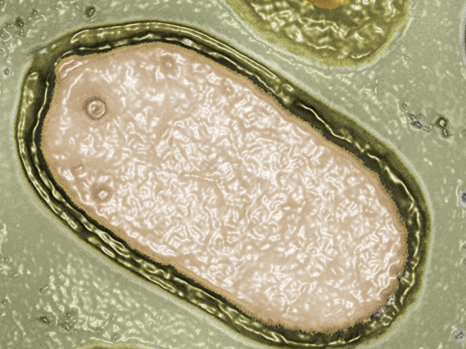Mimivirus, discovered 10 years ago, and more recently Megavirus chilensis [1], researchers thought they had reached the ultimate limit of the viral world in terms of size and genetic complexity. With a diameter close to the micron and a genome containing more than 1100 genes, these giant viruses that infect Acanthamoeba spp already widely encroached on the territory that was thought to be restricted to bacteria. For information, common viruses, such as influenza virus or the AIDS contain only a dozen genes.
In the study published in the journal Science, researchers announced the discovery of two new giant viruses: pandoravirus salinus on the Chilean coast, and pandoravirus dulcis in a pool of fresh water in Melbourne (Australia) <. / p>
 A detailed analysis of the first two Pandoravirus reveals they have almost nothing in common with the giant viruses previously characterized. In addition, only a small percentage (6%) encoded by the 2500 gene Pandoravirus salinus protein resembles already listed in other viruses or cellular organisms proteins. With a genome of this size, Pandoravirus salinus has shown that the complexity of the virus may exceed that of some eukaryotic cells [2]. Another singularity: Pandoravirus have no gene that allows them to make a protein resembling the capsid protein, the building block of traditional virus
A detailed analysis of the first two Pandoravirus reveals they have almost nothing in common with the giant viruses previously characterized. In addition, only a small percentage (6%) encoded by the 2500 gene Pandoravirus salinus protein resembles already listed in other viruses or cellular organisms proteins. With a genome of this size, Pandoravirus salinus has shown that the complexity of the virus may exceed that of some eukaryotic cells [2]. Another singularity: Pandoravirus have no gene that allows them to make a protein resembling the capsid protein, the building block of traditional virus
.
Despite all their original properties, Pandoravirus retain the essential characteristics of the viral world. absence of ribosome, energy production and division

Pandoravirus salinus observed by electron microscopy © IGS-CNRS AMU
In this context of absolute novelty, proteome analysis of Pandoravirus salinus has shown that proteins that are are those predicted from the genome sequence of the virus. The Pandoravirus therefore use the universal genetic code, code common to all living organisms on our planet.
This work highlights how our understanding of the microscopic biodiversity remains surprisingly partial as soon as you explore new environments. Indeed, Pandoravirus hitherto completely unknown, are probably not as rare as evidenced by the simultaneous discovery of two specimens of this new virus family in sediments located at 15,000 km distance.
The discovery was made definitely fills a gap between the viral world and the cellular world, discontinuity was a dogma since the foundation of modern virology in the 1950s. It also suggests that the emergence of cellular life could be accompanied by a more abundant variety of forms pre-cellular as classically considered, this new type of giant virus is virtually no homology with the three domains of life recognized : eukaryotes, eubacteria and archaebacteria
.
These results are published on the cover of the July 19, 2013 issue of the journal Science.
[1] Arslan D, Legendre M, Seltzer V, Abergel C, Claverie JM (2011) “Distant Mimivirus relative with a larger genome highlights the features of Fundamental Megaviridae”. Proc Natl Acad Sci USA. 108:
17486-91.
[2] These include microsporidia parasites of the genus Encephalitozoon.
News – Newsroom Inserm – Pandoravirus: discovery of a missing link between the viral world and the cellular world
Google+
Comments
comments
No comments:
Post a Comment